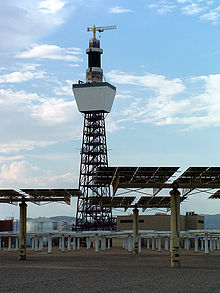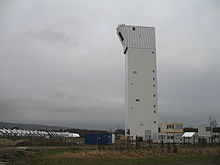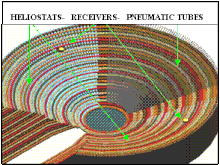Solar power tower

The solar power tower (also known as 'central tower' power plants or 'heliostat' power plants or power towers) is a type of solar furnace using a tower to receive the focused sunlight. It uses an array of flat, movable mirrors (called heliostats) to focus the sun's rays upon a collector tower (the target). Concentrated solar thermal is seen as one viable solution for renewable, pollution free energy production with currently available technology.
Early designs used these focused rays to heat water, and used the resulting steam to power a turbine. Newer designs using liquid sodium have been demonstrated, and systems using molten salts (40% potassium nitrate, 60% sodium nitrate) as the working fluids are now in operation. These working fluids have high heat capacity, which can be used to store the energy before using it to boil water to drive turbines. These designs allow power to be generated when the sun is not shining.
Examples of heliostat power plants


The 10 MW Solar One and Solar Two heliostat demonstration projects in the Mojave Desert have now been decommissioned. The 15 MW Solar Tres Power Tower in Spain builds on these projects. In Spain, the 11 MW PS10 solar power tower and 20 MW PS20 solar power tower[1] have been recently completed. In South Africa, Eskom completed a pre-feasibility study for 100 MW solar power plant with 4000 to 5000 heliostat mirrors, each having an area of 140 m². A site near Upington was used as a reference site to assess other potential sites.[2][3]
eSolar unveiled Sierra SunTower in the summer of 2009, a 5 MW plant located in Lancaster, California about 80 km (50 miles) northeast of Los Angeles. The project site occupies approximately 8 hectares (20 acres) in an arid valley in the western corner of the Mojave Desert at 35° north latitude. Sierra SunTower is interconnected to the Southern California Edison (SCE) grid and is the only CSP tower facility operating in North America.
BrightSource Energy entered into a series of power purchase agreements with Pacific Gas and Electric Company in March 2008 for up to 900 MW of electricity, the largest solar power commitment ever made by a utility.[4] BrightSource is currently developing a number of solar power plants in Southern California, with construction of the first plant planned to start in 2009.
In June 2008, BrightSource Energy dedicated its Solar Energy Development Center (SEDC) in Israel's Negev Desert. The site, located in the Rotem Industrial Park, features more than 1,600 heliostats that track the sun and reflect light onto a 60 meter-high tower. The concentrated energy is then used to heat a boiler atop the tower to 550 degrees Celsius, generating steam that is piped into a turbine, where electricity can be produced.[5]
| Power plants | Installed capacity (MW) |
Yearly production (TWh) |
Country | Developer/Owner |
|---|---|---|---|---|
| Sierra SunTower | 5[6] | United States | eSolar | |
| PS20 solar power tower | 20[7] | Spain | Abengoa | |
| Solar Tres Power Tower | 17 (under construction)[8] | Spain | Sener | |
| PS10 solar power tower | 11[9] | Spain | Abengoa |
Cost

The US National Renewable Energy Laboratory (NREL) has estimated that by 2020 electricity could be produced from power towers for 5.47 cents per kWh.[10] Companies such as ESolar (backed by Google.org) are continuing development of cheap, low maintenance, mass producible heliostat components that will reduce costs in the near future.[11]. ESolar's design uses large numbers of small mirrors (1.14m²) , which reduce costs for installing mounting systems such as concrete, steel, drilling & cranes.
Improvements in working fluid systems, such as moving from current two tank (hot/cold) designs to single tank thermocline systems with quartzite thermal fillers and oxygen blankets will improve material efficiency and reduce costs further.
Design
- Some Concentrating Solar Power Towers are air-cooled instead of water-cooled, to avoid using limited desert water [12]
- Flat glass is used instead of the more expensive curved glass [12]
- Some store the heat in molten salt containers to continue producing electricity while the sun is not shining
- Steam is heated to 500 C to drive turbines which generate electricity
Generally, installations use from 150 hectares (1,500,000 m2) to 320 hectares (3,200,000 m2).
Commercial applications

Recently, there has been a renewed interest in solar tower power technology, as is evident from the fact that there are several companies involved in planning, designing and building utility size power plants. This is an important step towards the ultimate goal of developing commercially viable plants. There are numerous example of case studies of applying innovative solution to solar power.[13]
Novel applications

The Pit Power Tower[14] combines a Solar Power Tower and an Aero-electric Power Tower[15] in a decommissioned open pit mine. Traditional Solar Power Towers are constrained in size by the height of the tower and closer heliostats blocking the line of sight of outer heliostats to the receiver. The use of the pit mine's "stadium seating" helps overcome the blocking constraint.
As Solar Power Towers commonly use steam to drive the turbines, and water tends to be scarce in regions with high solar energy, another advantage of open pits is that they tend to collect water, having been dug below the water table. The Pit Power Tower uses low heat steam to drive the Pneumatic Tubes in a co-generation system. A third benefit of re-purposing a pit mine for this kind of project is the possibility of reusing mine infrastructure such as roads, buildings and electricity.
See also
- List of solar thermal power stations
- Concentrating solar power
- Solar furnace
- Solar thermal energy
- List of concentrating solar thermal power companies
- Heliostat
References
- ^ "Spain plugs in largest solar-tower power plant". CNET News. 2009-04-28.
- ^ 100 MW Solar Thermal Electric Project in South Africa
- ^ http://www.sabregen.co.za Eskom Website
- ^ "BrightSource Energy signs whopper solar contract with PG&E". CNET News. 2008-03-31. Retrieved 2008-06-11.
- ^ "BrightSource / Luz II Dedicate Negev Solar Energy Development Center". Cleantech Investing in Israel. 2008-06-12. Retrieved 2008-06-12.
- ^ eSolar Ushers in New Era of Solar Energy with Unveiling of Sierra Power Plant
- ^ Abengoa Solar Begins Operation of World's Largest Solar Power Tower Plant
- ^ "SolarPACES". Retrieved 2009-11-09.
- ^ First EU Commercial Concentrating Solar Power Tower Opens in Spain
- ^ Assessment of Parabolic Trough and Power Tower Solar Technology Cost and Performance Forecasts
- ^ Google's Goal: Renewable Energy Cheaper than Coal November 27, 2007
- ^ a b http://www.brightsourceenergy.com/technology/faqs/
- ^ SOLAR POWER IN THE NEWS
- ^ http://www.itee.uq.edu.au/~aupec/aupec03/.../061%20Gwiazda%20full%20paper.pdf
- ^ http://en.wikipedia.org/wiki/Energy_tower
External links
- Cleantech Group picks winners and losers in concentrated solar thermal
- 'CSP' posts in Green Tech
- eSolar's demonstration plant in Lancaster, Calif.
- National Solar Thermal Test Facility
- Detailed Description of Central Receiver Systems
- Power Station Harnesses Sun's Rays BBC article about solar plant near Seville in Spain
- Description of first commercial Solar Power Tower
- vICERP A research cooperation with a demonstration plant in Juelich, Germany
- Solar Tower Plant Juelich Germany's first solar tower power plant in Juelich
- Heliostat fields on Google maps List of solar tower plants and solar furnaces with heliostat field on Google maps
- Zero Carbon Australia Stationery Energy Plan
Institutional links
- CSIRO > Divisions > CSIRO Energy Technology
- ESTELA > Technology > Tower Technology
- Promes Laboratory > Facilities > Solar concentrators > Themis
- PSA > Facilities > Central Receiver
- Sandia National Laboratory > National Solar Thermal Test Facility > Central Receiver Test Facility > Heliostats and tower capabilities
- Weizmann Institute > Environmental Sciences & Energy Research > Research > Energy Research
Commercial links
- Abengoa Solar > Technologies > Concentrating Solar Power > Power Tower
- Aora-Solar
- BrightSource Energy > Technology > How LPT Works
- Desertec > Concept > Technologies
- Device Logic
- eSolar > Our Projects
- Kraftanlagen München > Field of activities > Renewable energies > Solar thermal power plants > Jülich experimental power plant
- Nur Energie > Projects > Tunisia
- SENER > Projects > Gemasolar
- Solar Reserve > Technology
- Torresol Energy > Technologies > Own technologies > Central-tower technology
- Experimental Solar Thermal Power Plant Jülich (Kraftanlagen München) - YouTube
